African forest elephant
The African forest elephant (Loxodonta cyclotis) is one of the two living African elephant species. It is native to humid forests in West Africa and the Congo Basin. It is the smallest of the three living elephant species, reaching a shoulder height of 2.4 m (7 ft 10 in). Both sexes have straight, downpointing tusks, which erupt when they are 1–3 years old. It lives in family groups of up to 20 individuals. Since it forages on leaves, seeds, fruit, and tree bark, it has been referred to as the 'megagardener of the forest'. It contributes significantly to maintain the composition and structure of the Guinean Forests of West Africa and the Congolese rainforests.
| African forest elephant | |
|---|---|
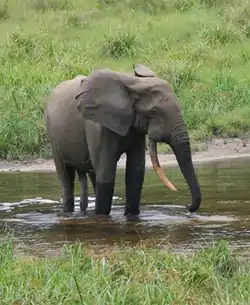 | |
| A bull in Ivindo National Park, Gabon | |
 | |
| A cow with her calf in Mbeli Bai, Nouabalé-Ndoki National Park, Republic of the Congo | |
| Scientific classification | |
| Kingdom: | Animalia |
| Phylum: | Chordata |
| Class: | Mammalia |
| Order: | Proboscidea |
| Family: | Elephantidae |
| Genus: | Loxodonta |
| Species: | L. cyclotis[2] |
| Binomial name | |
| Loxodonta cyclotis[2] (Matschie, 1900) | |
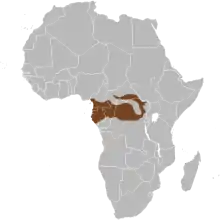 | |
| African forest elephant range | |
The first scientific description of the species was published in 1900. During the 20th century, the population declined due to hunting to less than 30,000 individuals estimated in 2013. It is threatened by habitat loss, fragmentation and poaching. The conservation status of populations varies across range countries.
Taxonomy
Loxodonte was proposed as the generic name for African elephants by Georges Cuvier in 1825. This name refers to the lozenge-shaped enamel of the molar teeth, which differs significantly from the shape of the Asian elephant's molar enamel.[3] Loxodonte was latinized to Loxodonta by an anonymous author in 1827.[4]
Elephas (Loxodonta) cyclotis was the scientific name proposed by Paul Matschie in 1900 who described the skulls of a female and a male specimen collected by the Sanaga River in southern Cameroon.[5]
Phylogeny
The African forest elephant was long considered to be a subspecies of the African elephant, together with the African bush elephant. Morphological and DNA analysis showed that they are two distinct species.[6][7]
The taxonomic status of the African pygmy elephant (Loxodonta pumilio) was uncertain for a long time. Phylogenetic analysis of the mitochondrial genome of nine specimens from museum collections indicates that it is an African forest elephant whose diminutive size or early maturity is due to environmental conditions.[8]
Phylogenetic analysis of nuclear DNA of African bush and forest elephants, Asian elephants, woolly mammoths and American mastodons revealed that the African forest elephant and African bush elephant form a sister group that genetically diverged at least 1.9 million years ago. They are therefore considered distinct species. Gene flow between the two species might have occurred after the split, though.[9] Analysis of ancient DNA from living and extinct elephantids indicates that the African forest elephant is one of three ancestors of the straight-tusked elephant (Palaeoloxodon antiquus).[10]
Characteristics
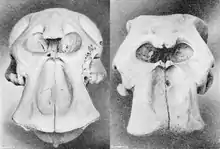
The African forest elephant has a grey skin, which looks yellow to reddish after wallowing. It is sparsely covered with black coarse hair, which is 20–200 mm (0.8–8 in) long around the tip of the tail. The length of the tail varies between individuals from half the height of the rump to almost touching ground. It has five toenails on the fore foot and four on the hind foot.[11] Its oval-shaped ears have small elliptical-shaped tips.[5] Its large ears help to reduce body heat; flapping them creates air currents and exposes the ears' inner sides where large blood vessels increase heat loss during hot weather.[12] Its back is nearly straight. Its tusks are straight and point downwards.[6]
Size
Bulls reach a shoulder height of 2.4–3.0 m (7.9–9.8 ft). Females are smaller at about 1.8–2.4 m (5.9–7.9 ft) tall at the shoulder. They reach a weight of 2–4 tonnes (2.2–4.4 short tons).[6] Foot print size ranges from 12.5 to 35.3 cm (4.9 to 13.9 in).[13]
Trunk
The tip of the trunk of African elephants has two finger-like processes. The trunk is a prehensile elongation of its upper lip and nose. This highly sensitive organ is innervated primarily by the trigeminal nerve, and thought to be manipulated by about 40–60,000 muscles. Because of this muscular structure, the trunk is so strong that elephants can use it for lifting about 3% of their own body weight. They use it for smelling, touching, feeding, drinking, dusting, producing sounds, loading, defending and attacking.[12]
Tusks and molars
The African forest elephant's tusks are straight and point downwards.[6] Both male and female African elephants have tusks that grow from deciduous teeth called tushes, which are replaced by tusks when calves are about one year old. Tusks are composed of dentin, which forms small diamond-shaped structures in the tusk's center that become larger at its periphery. A conical layer on their tips consisting of tooth enamel is usually worn off when the elephant is five years old.[12]
The African forest elephant has pink tusks, which are thinner and harder than the tusks of the African bush elephant. The length and diameter vary between individuals.[11] Tusks of bulls grow throughout life, tusks of cows cease growing when they are sexually mature.[6] They use their tusks for marking and debarking trees, digging for roots, minerals and water, to rest and protect the trunk, and also for defense and attack.[12]
The tusks are used to push through the dense undergrowth of their habitat.[14] Their tusks can grow to about 1.5 m (5 ft) long and can weigh between 23 and 45 kg (50 and 100 lb).[15]
Distribution and habitat
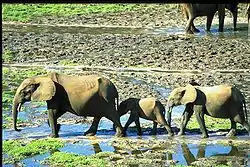
The African forest elephant is distributed in the evergreen moist deciduous Upper Guinean forests in Ivory Coast and Ghana.[16][17][18] Populations in Central Africa range in large contiguous rainforest tracts from Cameroon to the Democratic Republic of the Congo.[19][20][21] The largest stable population lives in Gabon.[22]
Behaviour and ecology
.jpg.webp)
.jpg.webp)
.jpg.webp)
The African forest elephant lives in family groups. Groups observed in the rain forest of Gabon's Lopé National Park between 1984 and 1991 comprised between three and eight individuals.[23] Groups of up to 20 individuals were observed in the Dzanga-Sangha Complex of Protected Areas, comprising adult cows, their daughters and subadult sons. Family members look after calves together, called allomothering. Once young bulls reach sexual maturity, they separate from the family group and form loose bachelor groups for a few days, but usually stay alone. Adult bulls associate with family groups only during the mating season. Family groups travel about 7.8 km (4.8 mi) per day and move in a home range of up to 2,000 km2 (770 sq mi).[11] Their seasonal movement is related to the availability of ripe fruits in Primary Rainforests.[24] They use a complex network of permanent trails that pass through stands of fruit trees and connect forest clearings with mineral licks.[25] These trails are reused by humans and other animals.[26]
In Odzala-Kokoua National Park, groups were observed to frequently meet at forest clearings indicating a fission–fusion society. They stayed longer when other groups were also present. Smaller groups joined large groups, and bulls joined family units.[27]
Diet

The African forest elephant is an herbivore. Elephants observed in Lopé National Park fed mostly tree bark and leaves, and at least 72 different fruits.[23] To supplement their diet with minerals, they congregate at mineral-rich waterholes and mineral licks.[28][29]
Elephant dung piles collected in Kahuzi-Biéga National Park contained seeds and fruit remains of Omphalocarpum mortehanii, junglesop (Anonidium mannii), Antrocaryon nannanii, Klainedoxa gabonensis, Treculia africana, Tetrapleura tetraptera, Uapaca guineensis, Autranella congolensis, Gambeya africana and G. lacourtiana, Mammea africana, Cissus dinklagei, and Grewia midlbrandii.[30] Dung piles collected in a lowland rain forest in the northern Republic of Congo contained seeds of at least 96 plant species, with a minimum of 30 intact seeds and up to 1102 large seeds of more than 1 cm (0.39 in) in a single pile. Based on the analysis of 855 dung piles, it has been estimated that African forest elephants disperse a daily mean of 346 large seeds per 1 km2 (0.39 sq mi) of at least 73 tree species; they transport about a third of the large seeds for more than 5 km (3.1 mi).[31]
Seeds passed by elephant gut germinate faster. The African forest elephant is one of the most effective seed dispersers in the tropics and has been referred to as the "megagardener of the forest" due to its significant role in maintaining plant diversity.[32] In the Cuvette Centrale, 14 of 18 megafaunal tree species depend on seed dissemination by African forest elephants, including wild mango (Irvingia gabonensis), Parinari excelsa and Tridesmostemon omphalocarpoides. These 14 species are not able to survive without elephants.[33] African forest elephants provide ecological services that maintain the composition and structure of Central African forests.[34]
Communication
Since this species is newly recognized, little to no literature is available on communication and perception. For these mammals, hearing and smell are the most important senses they possess because they do not have good eyesight. They can recognize and hear vibrations through the ground and can detect food sources with their sense of smell. Elephants are also an arrhythmic species, meaning they have the ability to see just as well in dim light as they can in the daylight. They are capable of doing so because the retina in their eyes adjusts nearly as quickly as light does.[35][36]
The elephant's feet are sensitive and can detect vibrations through the ground, whether thunder or elephant calls, from up to 10 miles away.[37]
Reproduction
Females reach sexual maturity between the age of 8 and 12 years, depending on the population density and nutrition available. On average, they begin breeding at the age of 23 and give birth every 5–6 years. As a result, the birth rate is lower than the bush species, which starts breeding at age 12 and has a calf every 3–4 years.[38] That time allows mothers to devote all the attention that the calf needs to teach it all the complex tasks that come with being an elephant, such as using their trunk to eat, wash, and drink.
Baby elephants weigh around 105 kg (232 lb) at birth. Almost immediately, they can stand up and move around, allowing the mother to roam around and forage, which is also essential to reduce predation. The baby suckles using its mouth while its trunk is held over its head. Their tusks do not come until around 16 months and calves are not weaned until they are roughly 4 or 5 years old. By this time, their tusks are around 14 cm long and begin to get in the way of suckling.[39]
Forest elephants have a lifespan of about 60 to 70 years and mature slowly, coming to puberty in their early teens.[40] Bulls generally pass puberty within the next year or two of females. Between the ages of 15 and 25, bulls experience "musth", which is a hormonal state they experience marked by increased aggression. The male secretes fluid from the temporal gland between its ear and eye during this time. Younger bulls often experience musth for a shorter period of time, while older bulls do for a longer time. When undergoing musth, bulls have a more erect walk with their heads high and tusks inward, they may rub their heads on trees or bushes to spread the musth scent, and they may even flap their ears, accompanied by a musth rumble, so that their smell can be blown towards other elephants. Another behavior affiliated with musth is urination. Bulls allow their urine to slowly come out and spray the insides of their hind legs. All of these behaviors are to advertise to receptive females and competing bulls they are in the musth state. Bulls only return to the herd to breed or to socialize, they do not provide prenatal care to their offspring but rather play a fatherly role to younger bulls to show dominance.[41]
The females are polyestrous, which means that they are capable of conceiving multiple times a year, which is a reason as to why they do not appear to have a breeding season. However, there does appear to be a peak in conceptions during the two rainy seasons of the year. Generally, the female conceives after two or three matings. Although the female has plenty of room in her uterus to gestate twins, twins are rarely conceived. The female African forest elephant's pregnancy lasts 22 months. Based on the maturity, fertility, and gestation rates, African forest elephants have the capabilities of increasing the species' population size by 5% annually under ideal conditions.[42]
Threats
Both African elephant species are threatened foremost by habitat loss and habitat fragmentation following conversion of forests for plantations of non-timber crops, livestock farming, and building urban and industrial areas. As a result, human-elephant conflict has increased. Poaching for ivory and bushmeat is a significant threat in Central Africa.[1]
Civil unrest, human encroachment, and habit fragmentation leaves some elephants confined to small patches of forest without sufficient food. In January 2014, International Fund for Animal Welfare undertook a relocation project at the request of the Ivory Coast government, moving four elephants from Daloa to Assagny National Park.[43]
Poaching
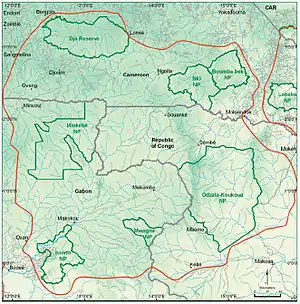
Genetic analysis of confiscated ivory showed that 328 tusks of African forest elephants seized in the Philippines between 1996 and 2005 originated in the eastern Democratic Republic of the Congo; 2,871 tusks seized in Hong Kong between 2006 and 2013 originated in Tridom, the tri-national Dja-Odzala-Minkébé protected area complex and the adjacent Dzanga Sangha Reserve in the Central African Republic. So did partly worked ivory confiscated between 2013 and 2014 at warehouses in Togo comprising 4,555 kg (10,042 lb) of tusks.[44] The hard ivory of the African forest elephant makes for more enhanced carving and fetches a higher price on the black market. This preference is evident in Japan, where hard ivory has nearly monopolized the trade for some time. Premium quality bachi, a traditional Japanese plucking tool used for string instruments, are contrived exclusively from African forest elephants tusks. In the impenetrable and often trackless expanses of the rain forests of the Congo Basin, poaching is extremely difficult to detect and track. Levels of off-take, for the most part, are estimated from ivory seizures. The scarcely populated and unprotected forests in Central Africa are most likely becoming increasingly alluring to organized poacher gangs.[45]
Late in the 20th century, conservation workers established a DNA identification system to trace the origin of poached ivory. Due to poaching to meet high demand for ivory, the African forest elephant population approached critical levels in the 1990s and early 2000s.[46][47] Over several decades, numbers are estimated to have fallen from approximately 700,000 to less than 100,000, with about half of the remaining population in Gabon.[48] In May 2013, Sudanese poachers killed 26 elephants in the Central African Republic's Dzanga Bai World Heritage Site.[49][50] Communications equipment, video cameras, and additional training of park guards were provided following the massacre to improve protection of the site.[51] From mid-April to mid-June 2014, poachers killed 68 elephants in Garamba National Park, including young ones without tusks.[52]
At the request of President Ali Bongo Ondimba, twelve British soldiers traveled to Gabon in 2015 to assist in training park rangers following the poaching of many elephants in Minkebe National Park.[53]
Bushmeat trade
It is not ivory alone that drives African forest elephant poaching. Killing for bushmeat in Central Africa has evolved into an international business in recent decades with markets reaching New York and other major cities of the United States; and the industry is still on the rise. This illegal market poses the greatest threat not only to forest elephants where hunters can target elephants of all ages, including calves, but to all of the larger species in the forests. There are actions that can be taken to lower the incentive for supplying to the bushmeat market. Regional markets, and the international trade, require the transporting of extensive amounts of animal meat which, in turn, requires the utilisation of vehicles. Having checkpoints on major roads and railroads can potentially help disrupt commercial networks.[45] In 2006, it was estimated that 410 African forest elephants are killed yearly in the Cross-Sanaga-Bioko coastal forests.[54]
Conservation
In 1986, the African Elephant Database was initiated with the aim to monitor the status of African elephant populations. This database includes results from aerial surveys, dung counts, interviews with local people and data on poaching.[55]
Both African elephant species have been listed by the Convention on International Trade in Endangered Species of Wild Fauna and Flora on CITES Appendix I since 1989. This listing banned international trade of African elephants and their body parts by countries that signed the CITES agreement. Hunting elephants is banned in the Central African Republic, Democratic Republic of Congo, Gabon, Côte d'Ivoire, and Senegal.[56]
African forest elephants are estimated to constitute up to one-third of the continent's elephant population, but have been poorly studied because of the difficulty in observing them through the dense vegetation that makes up their habitat.[57] Thermal imaging has facilitated observation of the species, leading to more information on their ecology, numbers, and behavior, including their interactions with elephants and other species. Scientists have learned more about how the elephants, who have poor night vision, negotiate their environment using only their hearing and olfactory senses. They also appeared to be much more active sexually during night compared to the day, which was unexpected.[42]
References
- Blanc, J. (2008). "Loxodonta africana". IUCN Red List of Threatened Species. 2008: e.T12392A3339343. Retrieved 8 June 2019.
- Shoshani, J. (2005). "Loxodonta cyclotis". In Wilson, D.E.; Reeder, D.M (eds.). Mammal Species of the World: A Taxonomic and Geographic Reference (3rd ed.). Johns Hopkins University Press. p. 91. ISBN 978-0-8018-8221-0. OCLC 62265494.
- Cuvier, G. (1825). "Éléphants d'Afrique". In Geoffroy-Saint-Hilaire, É.; Cuvier, F. (eds.). Histoire Naturelle des Mammifères, avec des figures originales, coloriées, dessinées d'après des animaux vivans. Tome 6. Paris: A. Belain. pp. 117–118.
- Anonymous (1827). "Analytical Notices of Books. Histoire Naturelle des Mammifères, avec des Figures originale, dessinées d'après des Animaux vivans; &c. Par MM. Geoffroy-Saint-Hilaire, et F. Cuvier. Livraison 52 et 53". The Zoological Journal. 3 (9): 140–143.
- Matschie, P. (1900). "Geographische Abarten des Afrikanischen Elefanten". Sitzungsberichte der Gesellschaft Naturforschender Freunde zu Berlin. 3: 189–197.
- Grubb, P.; Groves, C. P.; Dudley, J. P. & Shoshani, J. (2000). "Living African elephants belong to two species: Loxodonta africana (Blumenbach, 1797) and Loxodonta cyclotis (Matschie, 1900)". Elephant. 2 (4): 1–4. doi:10.22237/elephant/1521732169.
- Roca, A. L.; Georgiadis, N.; Pecon-Slattery, J. & O'Brien, S. J. (2001). "Genetic Evidence for Two Species of Elephant in Africa". Science. 293 (5534): 1473–1477. Bibcode:2001Sci...293.1473R. doi:10.1126/science.1059936. PMID 11520983. S2CID 38285623.
- Debruyne, R.; van Holt, A.; Barriel, V. & Tassy, P. (2003). "Status of the so-called African pygmy elephant (Loxodonta pumilio (Noack 1906)): phylogeny of cytochrome b and mitochondrial control region sequences". Comptes Rendus Biologies. 326 (7): 687–697. doi:10.1016/S1631-0691(03)00158-6. PMID 14556388.
- Rohland, N.; Reich, D.; Mallick, S.; Meyer, M.; Green, R. E.; Georgiadis, N. J.; Roca, A. L. & Hofreiter, M. (2010). "Genomic DNA Sequences from Mastodon and Woolly Mammoth Reveal Deep Speciation of Forest and Savanna Elephants". PLOS Biology. 8 (12): e1000564. doi:10.1371/journal.pbio.1000564. PMC 3006346. PMID 21203580.
- Palkopoulou, E.; Lipson, M.; Mallick, S.; Nielsen, S.; Rohland, N.; Baleka, S.; Karpinski, E.; Ivancevic, A. M.; To, T. H.; Kortschak, D.; Raison, J. M. & Qu, Z. (2018). "A comprehensive genomic history of extinct and living elephants". Proceedings of the National Academy of Sciences. 115 (11): E2566–E2574. doi:10.1073/pnas.1720554115. PMC 5856550. PMID 29483247.
- Turkalo, A.; Barnes, R. (2013). "Loxodonta cyclotis Forest Elephant". In Kingdon, J.; Happold, D.; Hoffmann, M.; Butynski, T.; Happold, M.; Kalina, J. (eds.). The Mammals of Africa. Volume I. Introductory Chapters and Afrotheria. London: Bloomsbury Publishing. pp. 195–200. ISBN 9781408189962.
- Shoshani, J. (1978). "General information on elephants with emphasis on tusks". Elephant. 1 (2): 20–31. doi:10.22237/elephant/1491234053.
- Morgan, B. J.; Lee, P. C. (2003). "Forest elephant (Loxodonta africana cyclotis) stature in the Reserve de Faune du Petit Loango, Gabon". Journal of Zoology. 259 (4): 337–344. doi:10.1017/s0952836902003291.
- Groning, K.; Saller, M. (1999). Elephants: a Cultural and Natural History. Cologne: Koneman.
- "Facts About African Elephants - The Maryland Zoo in Baltimore". The Maryland Zoo in Baltimore. Retrieved 2017-06-30.
- Roth, H. H.; Douglas-Hamilton, I. (1991). "Distribution and status of elephants in West Africa" (PDF). Mammalia. 55 (4): 489–528. doi:10.1515/mamm.1991.55.4.489. S2CID 85307838.
- Dudley, J. P.; Mensah‐Ntiamoah, A. Y.; Kpelle, D. G. (1992). "Forest elephants in a rainforest fragment: preliminary findings from a wildlife conservation project in southern Ghana". African Journal of Ecology. 30 (2): 116–126. doi:10.1111/j.1365-2028.1992.tb00485.x.
- Eggert, L. S.; Eggert, J. A.; Woodruff, D. S. (2003). "Estimating population sizes for elusive animals: the forest elephants of Kakum National Park, Ghana". Molecular Ecology. 12 (6): 1389–1402. doi:10.1046/j.1365-294X.2003.01822.x. PMID 12755869. S2CID 19346262.
- Tchamba, M. N.; Seme, P. M. (1993). "Diet and feeding behaviour of the forest elephant in the Santchou Reserve, Cameroon". African Journal of Ecology. 31 (2): 165–171. doi:10.1111/j.1365-2028.1993.tb00529.x.
- Blake, S.; Deem, S. L.; Strindberg, S.; Maisels, F.; Momont, L.; Isia, I. B.; Douglas-Hamilton, I.; Karesh, W. B.; Kock, M. D. (2008). "Roadless wilderness area determines forest elephant movements in the Congo Basin". PLOS ONE. 3 (10): e3546. Bibcode:2008PLoSO...3.3546B. doi:10.1371/journal.pone.0003546. PMC 2570334. PMID 18958284.
- Alers, M. P. T.; Blom, A.; Kiyengo, C. S.; Masunda, T.; Barnes, R. F. W. (1992). "Preliminary assessment of the status of the forest elephant in Zaire". African Journal of Ecology. 30 (4): 279–291. doi:10.1111/j.1365-2028.1992.tb00504.x.
- Barnes, R. F. W.; Beardsley, K.; Michelmore, F.; Barnes, K. L.; Alers, M. P. T.; Blom, A. (1997). "Estimating forest elephant numbers with dung counts and a geographic information system". The Journal of Wildlife Management. 61 (4): 1384–1393. doi:10.2307/3802142. JSTOR 3802142.
- White, L. J. T.; Tutin, C. E. G. & Fernandez, M. (1993). "Group composition and diet of forest elephants, Loxodonta africana cyclotis Matschie 1900, in the Lopé Reserve, Gabon". African Journal of Ecology. 31 (3): 181–199. doi:10.1111/j.1365-2028.1993.tb00532.x.
- Short, J. C. (1983). "Density and seasonal movements of forest elephant (Loxodonta africana cyclotis, Matschie) in Bia National Park, Ghana". African Journal of Ecology. 21 (3): 175–184. doi:10.1111/j.1365-2028.1983.tb01179.x.
- Blake, S. & Inkamba‐Nkulu, C. (2004). "Fruit, minerals, and forest elephant trails: do all roads lead to Rome?" (PDF). Biotropica. 36 (3): 392–401. doi:10.1111/j.1744-7429.2004.tb00332.x.
- Santoro, Helen (15 October 2020). "How Humans Benefit From a Highway of Trails Created by African Forest Elephants". Smithsonian. Retrieved 19 October 2020.
- Fishlock, V. & Lee, P. C. (2013). "Forest elephants: fission–fusion and social arenas". Animal Behaviour. 85 (2): 357–363. doi:10.1016/j.anbehav.2012.11.004. S2CID 53147174.
- Vanleeuwe, H.; Gautier-Hion, A.; Cajani, S. (1997). "Forest clearings and the conservation of elephants (Loxodonta africana cyclotis) in northeast Congo Republic". Pachyderm. 24: 46–52.
- Klaus, G.; Klaus-Hugi, C. & Schmid, B. (1998). "Geophagy by large mammals at natural licks in the rain forest of the Dzanga National Park, Central African Republic" (PDF). Journal of Tropical Ecology. 14 (6): 829–839. doi:10.1017/S0266467498000595.
- Yumoto, T.; Maruhashi, T.; Yamagiwa, J. & Mwanza, N. (1995). "Seed-Dispersal by Elephants in a Tropical Rain Forest in Kahuzi-Biega National Park, Zaire". Biotropica. 27 (4): 526–530. doi:10.2307/2388968. JSTOR 2388968.
- Blake, S.; Deem, S. L.; Mossimbo, E.; Maisels, F. & Walsh, P. (2009). "Forest Elephants: Tree Planters of the Congo" (PDF). Biotropica. 41 (4): 459–468. doi:10.1111/j.1744-7429.2009.00512.x.
- Campos-Arceiz, A. & Blake, S. (2011). "Megagardeners of the forest – the role of elephants in seed dispersal" (PDF). Acta Oecologica. 37 (6): 542–553. Bibcode:2011AcO....37..542C. doi:10.1016/j.actao.2011.01.014.
- Beaune, D.; Fruth, B.; Bollache, L.; Hohmann, G. & Bretagnolle, F. (2012). "Doom of the elephant-dependent trees in a Congo tropical forest". Forest Ecology and Management. 295: 109–117. doi:10.1016/j.foreco.2012.12.041.
- Poulsen, J. R.; Rosin, C.; Meier, A.; Mills, E.; Nuñez, C. L.; Koerner, S. E.; Blanchard, E.; Callejas, J.; Moore, S. & Sowers, M. (2018). "Ecological consequences of forest elephant declines for Afrotropical forests" (PDF). Conservation Biology. 32 (3): 559–567. doi:10.1111/cobi.13035. PMID 29076179.
- "A Sight to Behold – Elephant Vision". The Kota Foundation. 2017.
- "Loxodonta cyclotis (African forest elephant)". Animal Diversity Web. Retrieved 2017-06-29.
- (Kingdon, 1979; Morgan and Lee, 2003; Roca, et al., 2001)
- Turkalo, A.; Wrege, P. H. & Wittemyer, G. (2017). "Slow intrinsic growth rate in forest elephants indicates recovery from poaching will require decades". Journal of Applied Ecology. 54 (1): 153–159. doi:10.1111/1365-2664.12764.
- "Forest Elephants - Loxodonta cyclotis". www.birds.cornell.edu. Retrieved 2017-06-30.
- Sukumar, R. (2003). The Living Elephants: Evolutionary Ecology, Behavior, and Conservation. New York: Oxford University Press.
- "Loxodonta cyclotis (African forest elephant)". Animal Diversity Web. Retrieved 2017-06-30.
- Turkalo, A. K.; Fay, J. M. (2001). "African Rain Forest Ecology and Conservation. Observations from the Dzanga Saline". In Weber, W.; White, L. J. T.; Vedder, A.; Naughton-Treves, L. (eds.). African Rain Forest Ecology and Conservation: An Interdisciplinary Perspective. New Haven and London: Yale University Press. pp. 207–213. ISBN 9780300084337.
- Russo, C. (2014). "Success and Tragedy: IFAW's Project to Relocate Elephants in Côte d'Ivoire". National Geographic.
- Wasser, S. K.; Brown, L.; Mailand, C.; Mondol, S.; Clark, W.; Laurie, C.; Weir, B. S. (2015). "Genetic assignment of large seizures of elephant ivory reveals Africa's major poaching hotspots". Science. 349 (6243): 84–87. Bibcode:2015Sci...349...84W. doi:10.1126/science.aaa2457. PMC 5535781. PMID 26089357.
- Nishihara, T. (2012). "Demand for forest elephant ivory in Japan" (PDF). Pachyderm (52): 55–65.
- Barnes RF, Beardsley K, Michelmore F, Barnes KL, Alers MP, Blom A (1997). "Estimating Forest Elephant Numbers with Dung Counts and a Geographic Information System". The Journal of Wildlife Management. 61 (4): 1384–1393. doi:10.2307/3802142. JSTOR 3802142.
- Barnes, R. F.; Alers, M. P.; Blom A. (1995). "A review of the status of forest elephants Loxodonta africana in central Africa". Biological Conservation. 71 (2): 125–132. doi:10.1016/0006-3207(94)00014-H.
- Gettleman, J. (2012). "In Gabon, Lure of Ivory Is Hard for Many to Resist". The New York Times.
- "At least 26 elephants massacred in World Heritage site". WWF Global. 2013.
- Neme, L. (2013). "Chaos and Confusion Following Elephant Poaching in a Central African World Heritage Site". National Geographic.
- Joyce, C.; McQuay, B. (2014). "Former Commando Turns Conservationist To Save Elephants Of Dzanga Bai". NPR.
- Schemm, P. (2014). "Poachers massacre elephants in Congo park". CTV News. The Associated Press.
- "British troops head to West Africa to help stem elephant slaughter". Belfast Telegraph. 2015.
- Fa, J. E.; Seymour, S.; Dupain, J. E. F.; Amin, R.; Albrechtsen, L. & Macdonald, D. (2006). "Getting to grips with the magnitude of exploitation: bushmeat in the Cross–Sanaga rivers region, Nigeria and Cameroon". Biological Conservation. 129 (4): 497–510. doi:10.1016/j.biocon.2005.11.031.
- Blanc, J. J.; Thouless, C. R.; Hart, J. A.; Dublin, H. T.; Douglas-Hamilton, I.; Craig, G. C.; Barnes, R. F. W. (2003). African Elephant Status Report 2002: An update from the African Elephant Database. Occasional Paper of the IUCN Species Survival Commission No. 29. Gland and Cambridge: IUCN. ISBN 9782831707075.
- Stiles, D.; Martin, E. (2001). "Status and trends of the ivory trade in Africa, 1989–1999" (PDF). Pachyderm (30): 24–36.
- Clabby, C. (2012). "Forest Elephant Chronicles". American Scientist. 100 (5): 416–417. doi:10.1511/2012.98.416.
Further reading
- Yasuko Ishida et al. (2018). Evolutionary and demographic processes shaping geographic patterns of genetic diversity in a keystone species, the African forest elephant (Loxodonta cyclotis). Ecology and Evolution.
- Stéphanie Bourgeois et al. (2018). Single‐nucleotide polymorphism discovery and panel characterization in the African forest elephant. Ecology and Evolution.
External links
| Wikimedia Commons has media related to: |
| Wikispecies has information related to Loxodonta cyclotis. |
- "Elephant Listening Project: Forest Elephants". The Cornell Lab, Cornell University.
- African Forest Elephant Foundation
- WCS.org: Forest Elephant Program
- ARKive .org: Images and movies of the forest elephant (Loxodonta cyclotis)
- BBC Wildlife Finder - video clips from the BBC archive
- PBS Nature: Tracking Forest Elephants
- Elephant Information Repository — in-depth resource on elephants.
- AWF.org: African Forest Elephant — photos and info.
